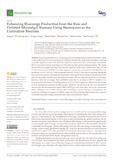JavaScript is disabled for your browser. Some features of this site may not work without it.
| dc.contributor.author | Li, Gang | |
| dc.contributor.author | Hao, Yuhang | |
| dc.contributor.author | Yang, Tenglun | |
| dc.contributor.author | Xiao, Wenbo | |
| dc.contributor.author | Pan, Minmin | |
| dc.contributor.author | Huo, Shuhao | |
| dc.contributor.author | Lyu, Tao | |
| dc.date.accessioned | 2022-11-15T10:16:10Z | |
| dc.date.available | 2022-11-15T10:16:10Z | |
| dc.date.issued | 2022-11-02 | |
| dc.identifier.citation | Li G, Hao Y, Yang T, et al., (2022) Enhancing bioenergy production from the raw and defatted microalgal biomass using wastewater as the cultivation medium. Bioengineering, Volume 9, Issue 11, November 2022, Article number 637 | en_UK |
| dc.identifier.issn | 2306-5354 | |
| dc.identifier.uri | https://doi.org/10.3390/bioengineering9110637 | |
| dc.identifier.uri | https://dspace.lib.cranfield.ac.uk/handle/1826/18709 | |
| dc.description.abstract | Improving the efficiency of using energy and decreasing impacts on the environment will be an inevitable choice for future development. Based on this direction, three kinds of medium (modified anaerobic digestion wastewater, anaerobic digestion wastewater and a standard growth medium BG11) were used to culture microalgae towards achieving high-quality biodiesel products. The results showed that microalgae culturing with anaerobic digestate wastewater could increase lipid content (21.8%); however, the modified anaerobic digestion wastewater can boost the microalgal biomass production to 0.78 ± 0.01 g/L when compared with (0.35–0.54 g/L) the other two groups. Besides the first step lipid extraction, the elemental composition, thermogravimetric and pyrolysis products of the defatted microalgal residues were also analysed to delve into the utilisation potential of microalgae biomass. Defatted microalgae from modified wastewater by pyrolysis at 650 °C resulted in an increase in the total content of valuable products (39.47%) with no significant difference in the content of toxic compounds compared to other groups. Moreover, the results of the life cycle assessment showed that the environmental impact (388.9 mPET2000) was lower than that of raw wastewater (418.1 mPET2000) and standard medium (497.3 mPET2000)-cultivated groups. Consequently, the method of culturing microalgae in modified wastewater and pyrolyzing algal residues has a potential to increase renewable energy production and reduce environmental impact. | en_UK |
| dc.language.iso | en | en_UK |
| dc.publisher | MDPI | en_UK |
| dc.rights | Attribution 4.0 International | * |
| dc.rights.uri | http://creativecommons.org/licenses/by/4.0/ | * |
| dc.subject | biodiesel | en_UK |
| dc.subject | waste recovery | en_UK |
| dc.subject | renewable energy | en_UK |
| dc.subject | microalgal technology | en_UK |
| dc.subject | life cycle assessment | en_UK |
| dc.title | Enhancing bioenergy production from the raw and defatted microalgal biomass using wastewater as the cultivation medium | en_UK |
| dc.type | Article | en_UK |
Files in this item
The following license files are associated with this item:
This item appears in the following Collection(s)
-
Staff publications (SWEE) [2828]

